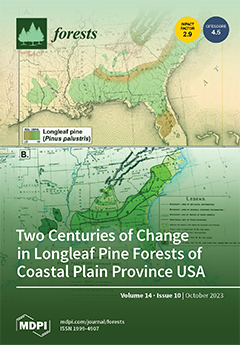Pine wilt disease has caused great economic loss and become an ecological threat since it was introduced into East Asia. In China,
Pinus massoniana Lamb. is highly susceptible. The pathogenic of this disease is linked to the invasion of
P. massoniana by the
[...] Read more.
Pine wilt disease has caused great economic loss and become an ecological threat since it was introduced into East Asia. In China,
Pinus massoniana Lamb. is highly susceptible. The pathogenic of this disease is linked to the invasion of
P. massoniana by the pine wood nematode (PWN,
Bursaphelenchus xylophilus), leading to various physiological activities. However, the migration pathway of PWN and the defense mechanisms of
P. massoniana tissue structure following invasion remain unclear. This knowledge is vital for understanding the pathogenesis of pine wood nematode disease. To address this issue, we analyzed the tissue structure damage, horizontal and vertical migration pathways, and histochemical reactions of
P. massoniana after PWN inoculation. The results are as follows: susceptible
P. massoniana exhibited more tissue structure damage compared to highly resistant
P. massoniana. PWN reproduced and migrated by feeding on and damaging cells. In susceptible
P. massoniana, PWN propagated and migrated throughout the entire plant. Highly resistant
P. massoniana displayed limited horizontal and vertical migration of PWN, making it challenging for PWNs to move from cambium to xylem. After
P. massoniana was damaged by PWNs, a protein cross-linking phenomenon appeared rapidly, with highly resistant
P. massoniana exhibiting less protein cross-linking than the susceptible variety. Lignin synthesis is a crucial factor in the tissue defense of
P. massoniana. Protein crosslinking provides time for lignin synthesis and is an vital component of tissue defense.
Full article





